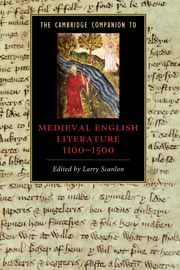13 - Julian of Norwich
from Part II - Authors
Published online by Cambridge University Press: 28 November 2009
Summary
Julian of Norwich, the fourteenth-century mystic and writer whose Showings recount a series of visions she had when she was “thirty and a half,” has gained in appeal throughout the late twentieth and early twenty-first centuries. With her description of God as both mother and father, her unwillingness to dwell upon sin and judgment, her carefully articulated discussion of divine love, and her refusal to claim for herself any special status, she speaks to the devotional needs of many who find themselves weary of the hegemonies of gender and power. She is a subtle theologian of quiet daring and one of the early masters of Middle English prose. Like other late fourteenth-century writers such as William Langland and Geoffrey Chaucer, she understood and exploited the inherent flexibilities of the vernacular as a medium of common and uncommon speech. In so doing, Julian at once drew upon a vigorous tradition of vernacular devotional prose and employed that tradition to reformulate the terms with which the divine nature and the human flesh it took as its clothing are understood.
The textual history of the Showings suggests both the extraordinary care she took as a writer and the vulnerabilities to which manuscript culture was subject. There are two sets of manuscripts. Julian wrote a Short Text recounting her visionary experience some years before she completed the Long Text of the Showings. The Long Text is a significant expansion of the earlier version, but it is also a careful reading and exposition of the visions she originally described that testifies to her growing sense of authority as a writer and a thinker. The Short Text survives in a mid-fifteenth-century collection, possibly of Carthusian provenance, of devotional texts, including some by Richard Rolle of Hampole, the important mid-century Yorkshire mystic, whose achievements in the vernacular almost match those of Julian. The Long Text survives complete in three seventeenth-century manuscripts; excerpts of it appear in a mid-fifteenth-century Westminster Cathedral manuscript, which also contains excerpts from The Scale of Perfection by her contemporary, Walter Hilton.
- Type
- Chapter
- Information
- The Cambridge Companion to Medieval English Literature 1100–1500 , pp. 179 - 190Publisher: Cambridge University PressPrint publication year: 2009

